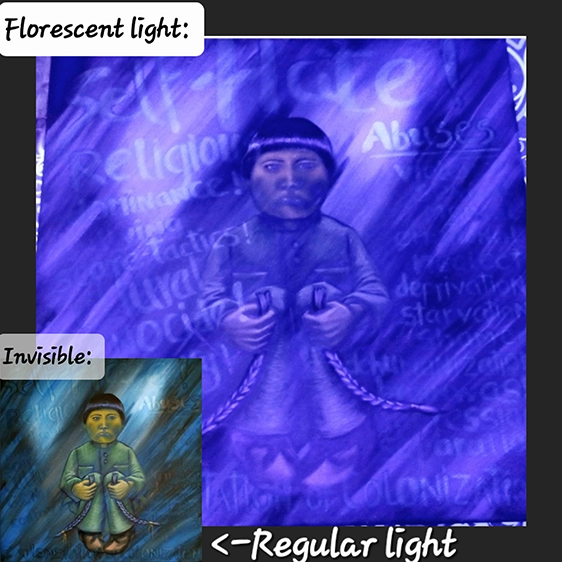
10 Flint Avenue, P.O. Box 398, Bancroft, Ontario K0L 1C0 Phone 613-332-1542 email: artgalleryofbancroft@gmail.ca
Proudly supported by:


“Implementation of Colonization” (installation)
Acrylic/invisible blue ink/canvas framed in a cardboard box bearing the words, “Kanabenindam (calm); Kwayakwakonigewin (justice); Wanakiwin (Peace); and Minawazi (happy), ”24 “x24”
What was implemented to an abused child survivor of an institutional system that conformed them into an apparent “Civil human society” that they call “Colonization.” Christianised Cults allowed them to mold these children into products of today’s First Nation Peoples of society. Many children remained unshorn, invisible from being targeted. Others, on the other hand, were visible and had to survive their abusers.
This picture depicts: a child in a residential school uniform who had his braids cut off, and as time will tell, he kept them. Symbolic of holding on to one’s cultured traditions that were hated and disrespected, of his Indigenous tribal language that was almost forgotten and his personage of “who he is born out of,” “Indigenous peoples”.
The child is sitting in darkness, because it was a very dark time for them: being taken away from their home and brought to a school where they knew absolutely no one; stripped of their home clothes, bathed and then had their heads shaven. This was a regular practice amongst the school systems at the time.
The child is framed in a box to signify how children had to fit into a system that made up parameters for them. The children could not go outside those parameters such as speaking their language, since it did not fit in their societal system. Even if it meant forgetting where they came from.
When you shine a light on the canvas you will see a list of works of implementation that some children endured in those days, I painted it with invisible ink; it can only be seen with a black florescent light.
This signifies that not all things are as they appear without shining a little light on the subject. When one sees an Indigenous person on the streets or at a bus stop who are intoxicated, these are probably some of the reasons as to why. They are trying to forget a dark past and the sacrifices these kids endured to build a country.
Little Bird is an Algonquin artist from Pikwakanagan, Ontario, who works with a variety of mediums from illustrating, painting, and photography to multi-media.
Having over 25 years of visual creative experience and a degree in Visual Creative Arts/Graphic Design, Little Bird has won several art awards, beginning in high school. From there, Little Bird (a proud alumni member of St. Lawrence College, Kingston) received a Multi-Media Certification from Toronto Image Works.
The alias “Little Bird” was created in the 1990s, while the artist was working as a graphic designer and illustrator for a First Nations company based in Montreal. Little Bird went silent for the past 25 years and has now been resurrected to take part in the “Truth and Reconciliation Project”.
Little Bird felt it was important to participate in this art show to express the Truth about the implementation of certain Colonization practices as a reminder of the difficult times the children of the residential school systems went through and endured.

10 Flint Avenue, P.O. Box 398, Bancroft, Ontario K0L 1C0 Phone 613-332-1542 email: artgalleryofbancroft@gmail.ca
Proudly supported by:

Charitable Registration #: 81973 7750 RR0001
How to Pay
Etransfer to artonflint@gmail.com
(Don’t forget to include your email address in the etransfer for your tax receipt!)
Drop in at the Gallery or mail us a cheque:
AGB, 10 Flint Avenue, P.O. Box 398, Bancroft, ON K0L 1C0
The Art Gallery of Bancroft is situated on the traditional territory of the Anishinaabeg Algonquins, which is known to be unceded. Indigenous people have been stewards of this land since time immemorial; as such we honour and respect their connection to the land, its plants, animals and stories. Our recognition of the contributions and historic importance of Indigenous peoples is sincerely aligned to our collective commitment to make the promise and the challenge of truth and reconciliation real in our community.